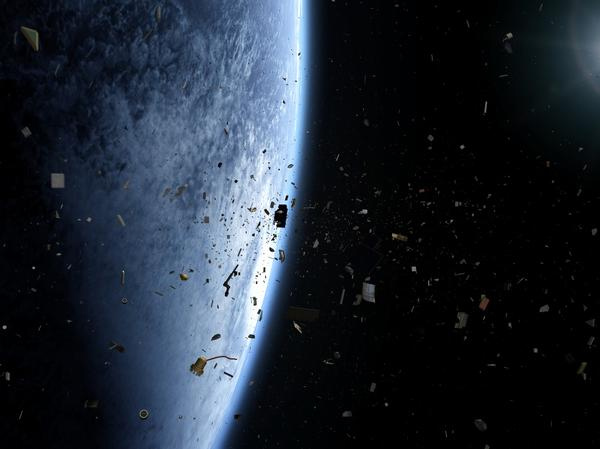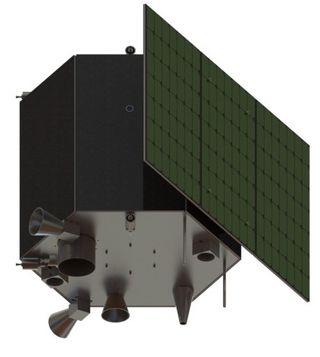
Boom! NASA to Demolish Spacecraft in the Name of Science

Work is underway to create a spacecraft that won't be rocketed into outer space but will be purposely destroyed on the ground.
DebriSat is a 110-pound (50 kilograms) satellite that's a double for a modern low-Earth orbit spacecraft in terms of its components, materials used, and fabrication procedures. But once fabricated and tested, DebriSat is doomed.
The spacecraft will be the target of a future hypervelocity impact experiment to examine the physical characteristics of debris created when two satellites collide.
NASA and the Air Force's Space and Missile Systems Center are co-sponsors of DebriSat. The NASA Orbital Debris Program Office at the Johnson Space Center in Houston is leading the effort. [Photos: Space Debris Images & Cleanup Concepts]
Impact risk assessments
Data gleaned from demolishing DebriSat will be valuable in the short- and long-term, said J. C. Liou of NASA's Orbital Debris Program Office.
"Collision fragments are expected to dominate the future orbital debris environment," Liou told SPACE.com. Therefore, he said, a high fidelity breakup model describing the outcome of a satellite collision — in terms of the fragment size, mass, area-to-mass ratio, shape, and composition distributions — is needed for reliable short- and long-term impact risk assessments.
Get the Space.com Newsletter
Breaking space news, the latest updates on rocket launches, skywatching events and more!
Those appraisals deal with debris as small as 1 millimeter for critical space assets and for good orbital debris environment definition, Liou said. Some of the distributions for "large" fragments can be obtained from the U.S. Space Surveillance Network (SSN) observations. But the SSN data are limited to 10-centimeter (4 inches) and larger objects. "Laboratory-based experiments are necessary to collect data for smaller debris," he said.
As a modern satellite target, obliterating DebriSat is expected to improve the NASA standard satellite breakup model.
Laboratory-based impact tests
Liou pointed out that the Department of Defense (DoD) and NASA have conducted quite a few laboratory-based impact tests in the past. One of the key experiments supporting the development of the NASA and DoD satellite breakup models was called SOCIT, short for Satellite Orbital debris Characterization Impact Test series.
In one SOCIT ground experiment in 1992, the target was a flight-ready U.S. Navy Transit satellite built in the 1960s. But that was then, and this is now. Present day satellites incorporate many different technologies and materials than spacecraft designed over 40 years ago.
"As new materials and new construction techniques are developed for modern satellites, there is a need to conduct additional laboratory-based tests and use the new data to further enhance the breakup models," Liou said.

Integrity of the destructive outcome
A University of Florida team is designing and fabricating DebriSat for its eventual demise.
To put DebriSat together, a wide-ranging study was done of past low-Earth orbit satellite designs and missions within the last 15 years for spacecraft ranging from one kilogram to 5,000 kilograms (2.2 pounds to 11,023 pounds).
This study identified modern trends in hardware, material, and construction practices utilized in recent LEO missions. While DebriSat is an engineering model, specific attention is being placed on the quality, type, and quantity of the materials used in its fabrication to ensure the integrity of the destructive outcome.
With the exception of software, all other aspects of the satellite's design, fabrication, and assembly integration and testing will be as rigorous as that of an actual flight vehicle, according to officials involved in the DebriSat effort.
DebriSat is now slated to undergo a hypervelocity impact test in early 2014, said Norman Fitz-Coy, associate professor in the Department of Mechanical and Aerospace Engineering and director of the Space Systems Group at the University of Florida, which is in Gainesville. He is leading the university's DebriSat team.
Labor intensive exercise
A hypervelocity impact test is one in which the amount of energy experienced during a typical impact between two orbiting satellites is replicated, Fitz-Coy told SPACE.com. The test will be performed at the Air Force's Arnold Engineering Development Center in Tennessee.
Once busted up, how much work is involved in piecing together just how the satellite reacted to the impact?
"We are not actually gluing the satellite back together," Fitz-Coy said. "Rather we are characterizing — size, shape, etc. — of the fragments resulting from the impact. This is a labor intensive exercise."
NASA's Liou said that after the hypervelocity test, the University of Florida experts will collect fragments down to roughly 0.08 inches (2 millimeters) in size. That's about as long as a nickel is thick.
The dimensions of the resulting fragments will then be measured individually. That data will be delivered to NASA and the Air Force Space and Missile Systems Center.
The NASA Orbital Debris Program Office will lead the effort to analyze the data and use the information to enhance the satellite breakup model, Liou said.
Leonard David has been reporting on the space industry for more than five decades. He is a winner of last year's National Space Club Press Award and a past editor-in-chief of the National Space Society's Ad Astra and Space World magazines. He has written for SPACE.com since 1999.
Join our Space Forums to keep talking space on the latest missions, night sky and more! And if you have a news tip, correction or comment, let us know at: community@space.com.

Leonard David is an award-winning space journalist who has been reporting on space activities for more than 50 years. Currently writing as Space.com's Space Insider Columnist among his other projects, Leonard has authored numerous books on space exploration, Mars missions and more, with his latest being "Moon Rush: The New Space Race" published in 2019 by National Geographic. He also wrote "Mars: Our Future on the Red Planet" released in 2016 by National Geographic. Leonard has served as a correspondent for SpaceNews, Scientific American and Aerospace America for the AIAA. He has received many awards, including the first Ordway Award for Sustained Excellence in Spaceflight History in 2015 at the AAS Wernher von Braun Memorial Symposium. You can find out Leonard's latest project at his website and on Twitter.










